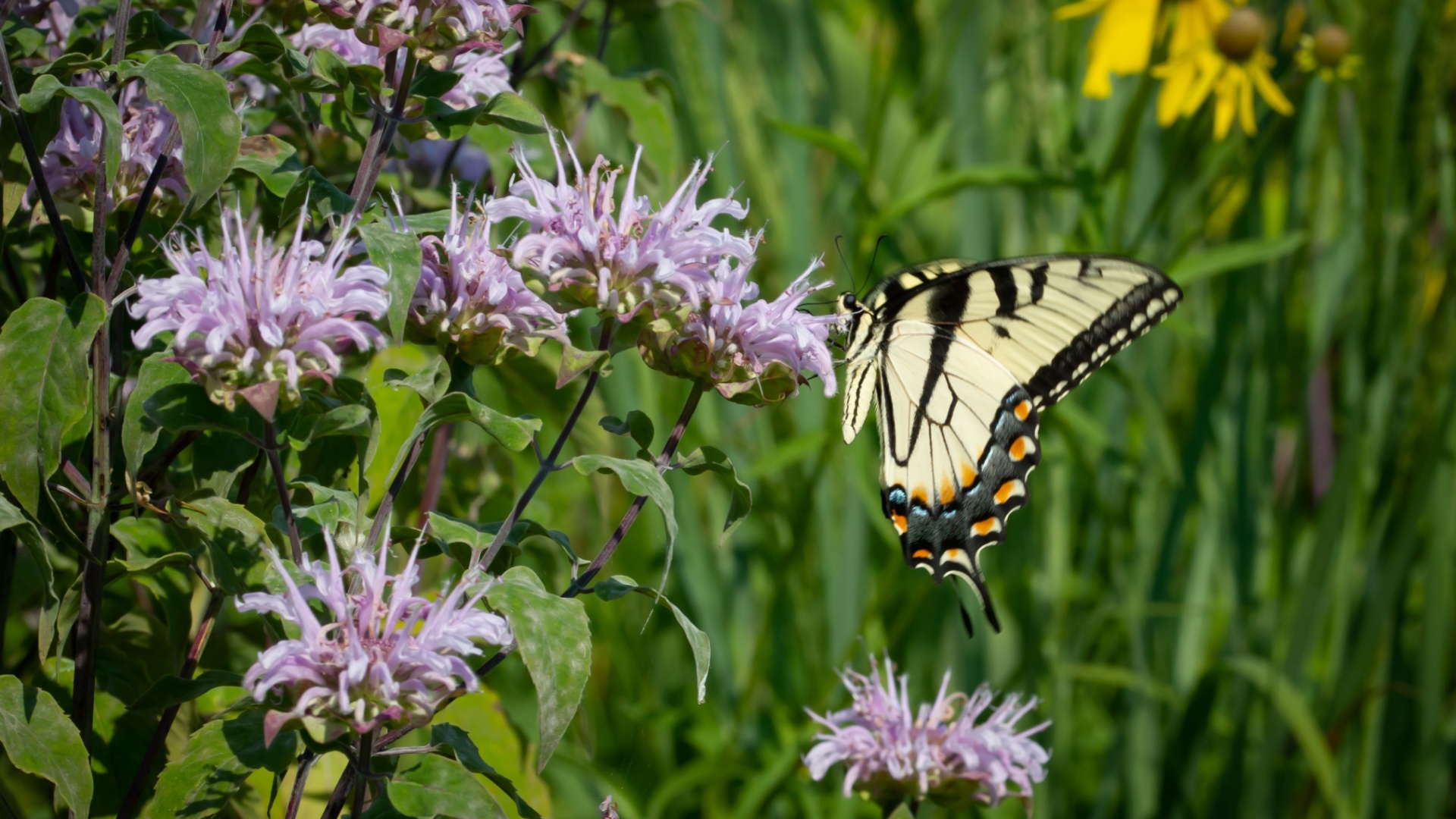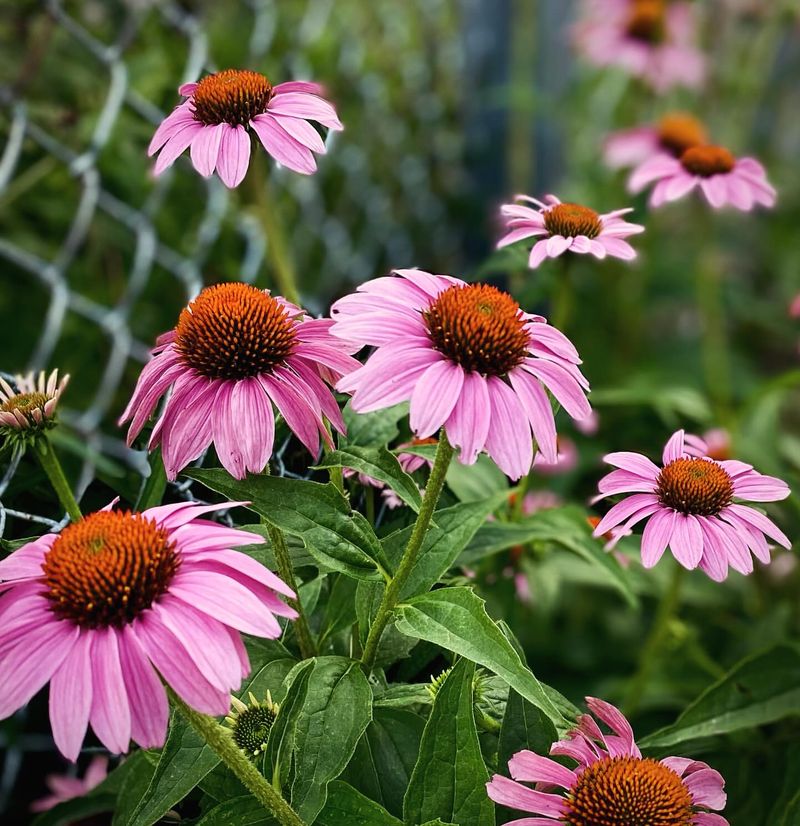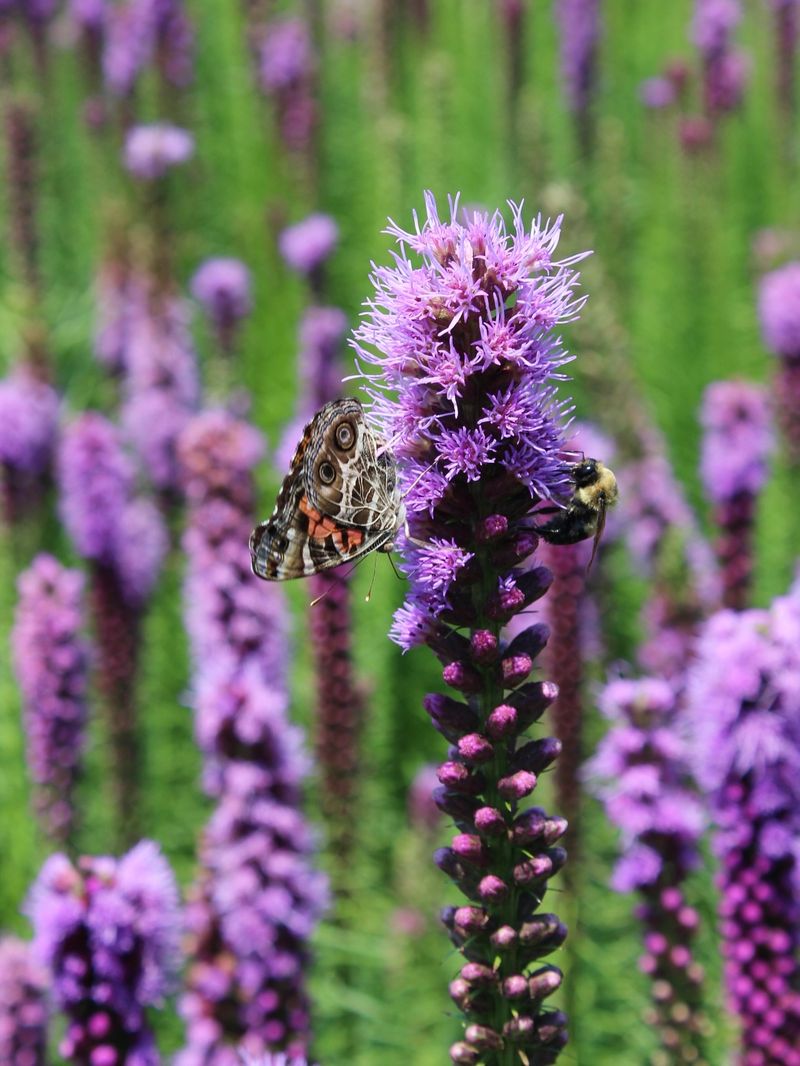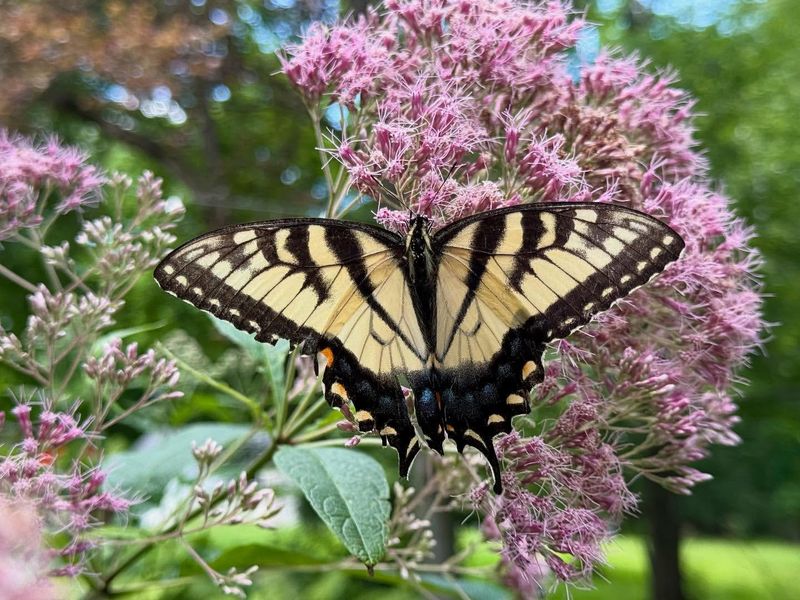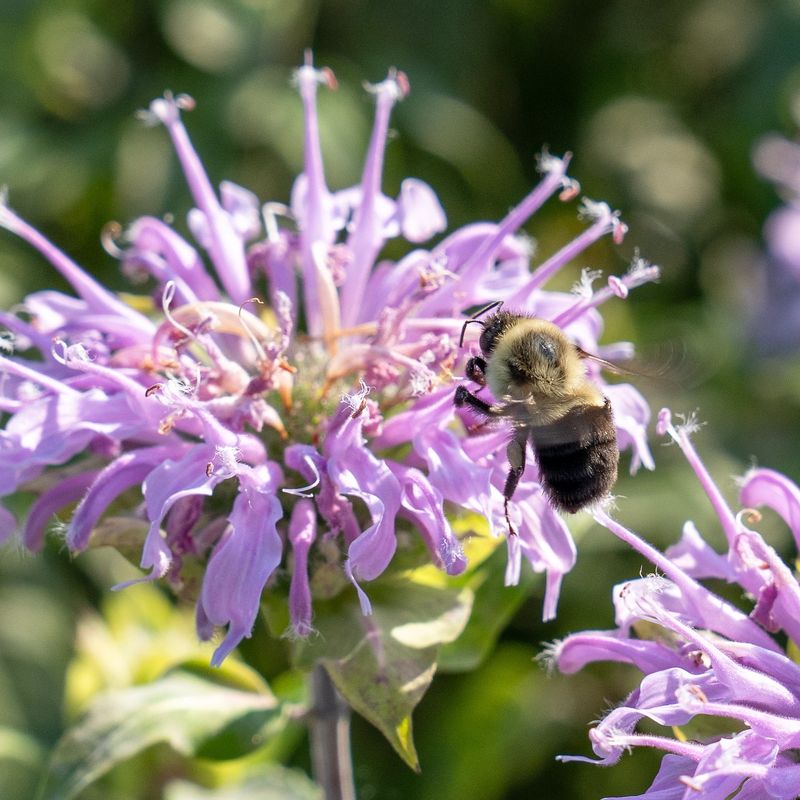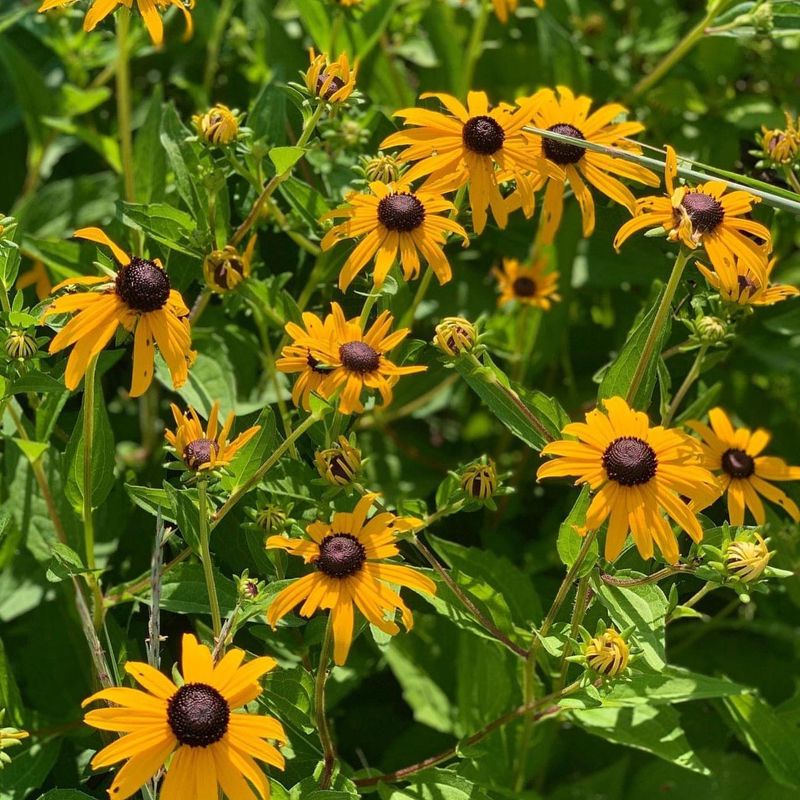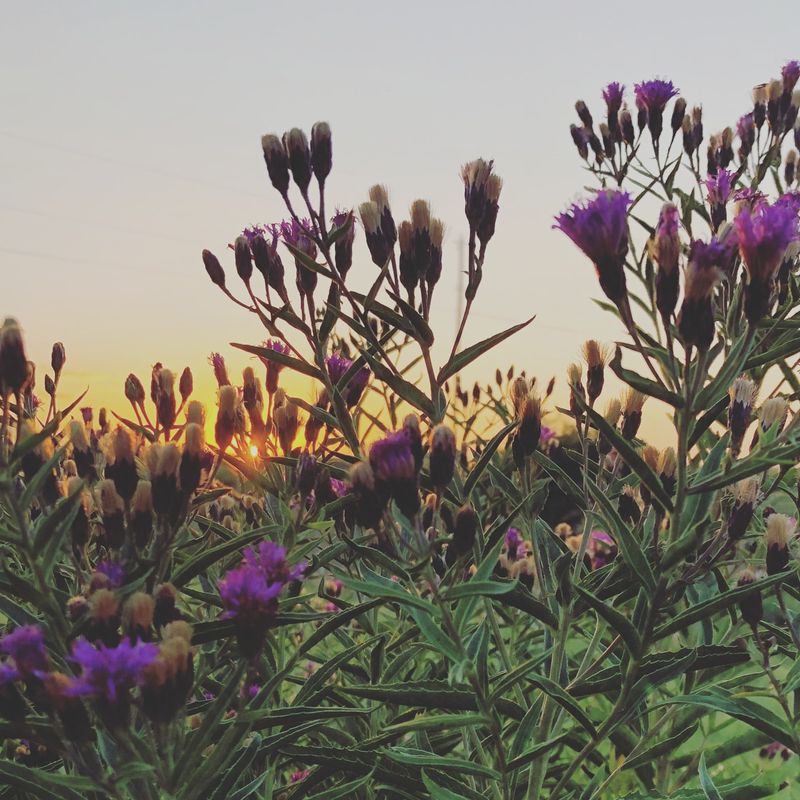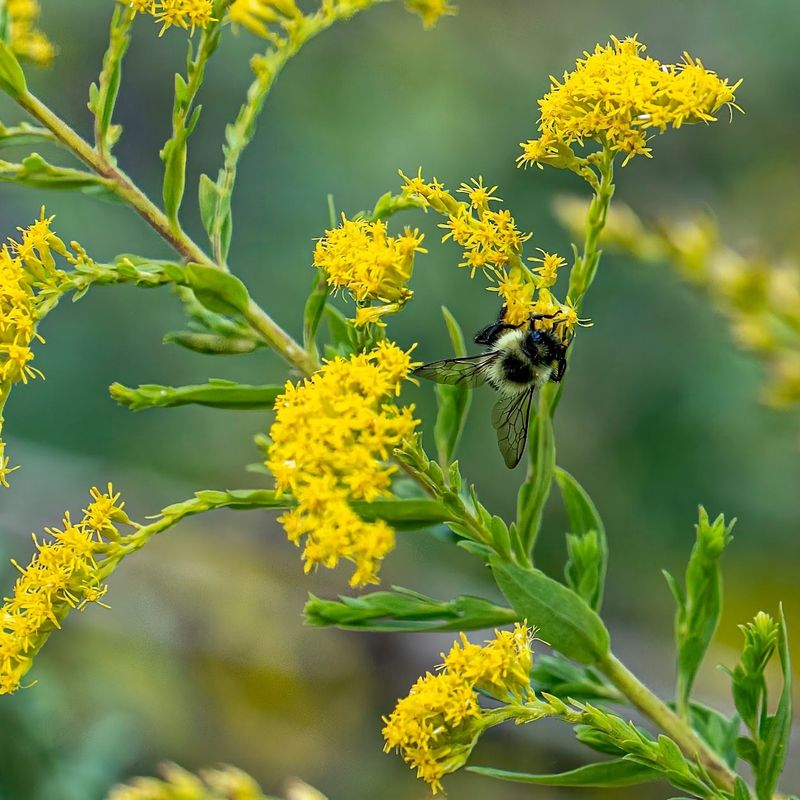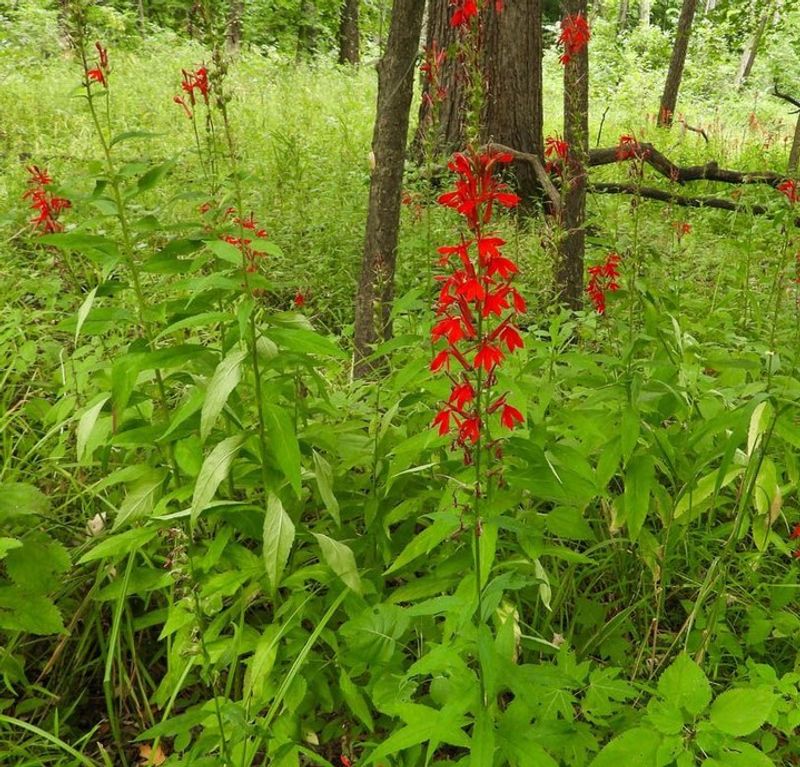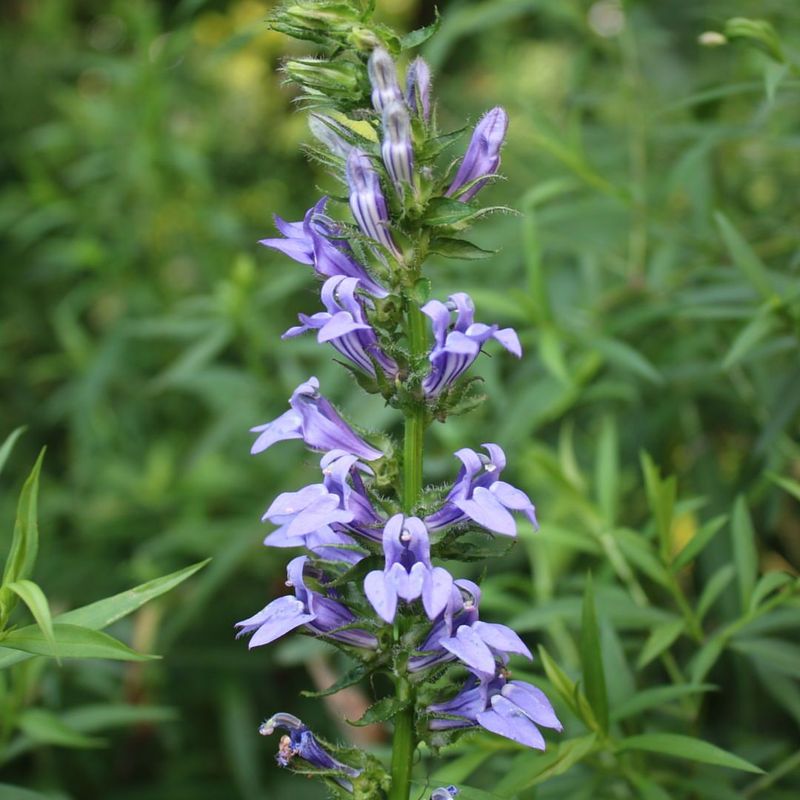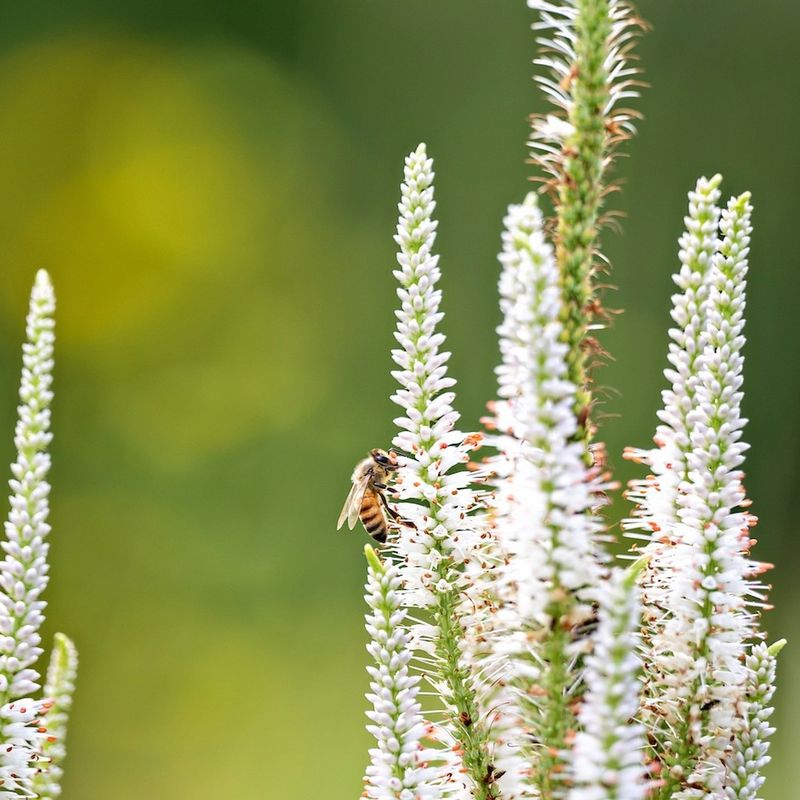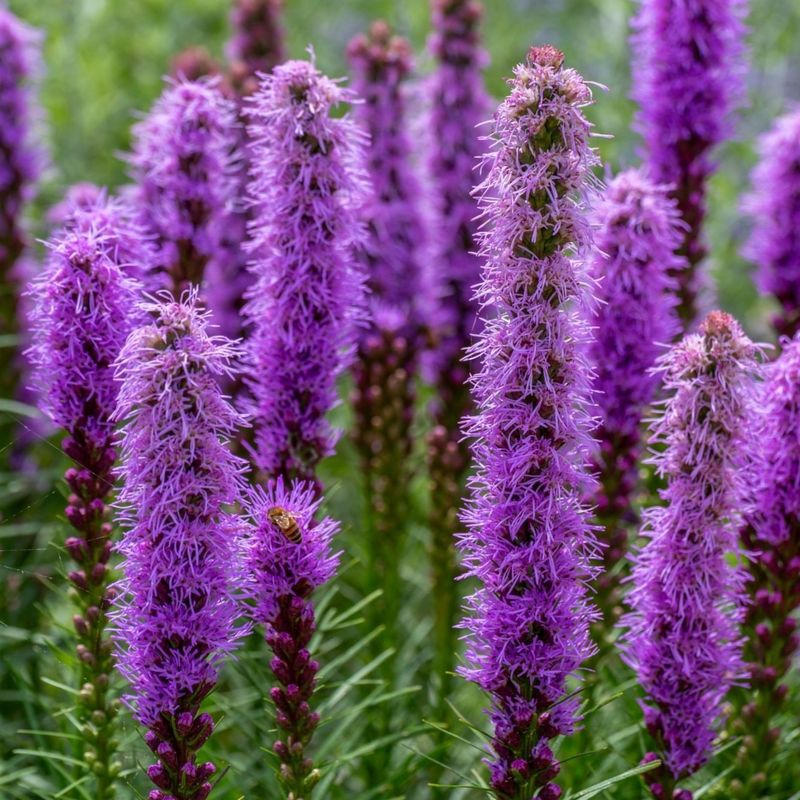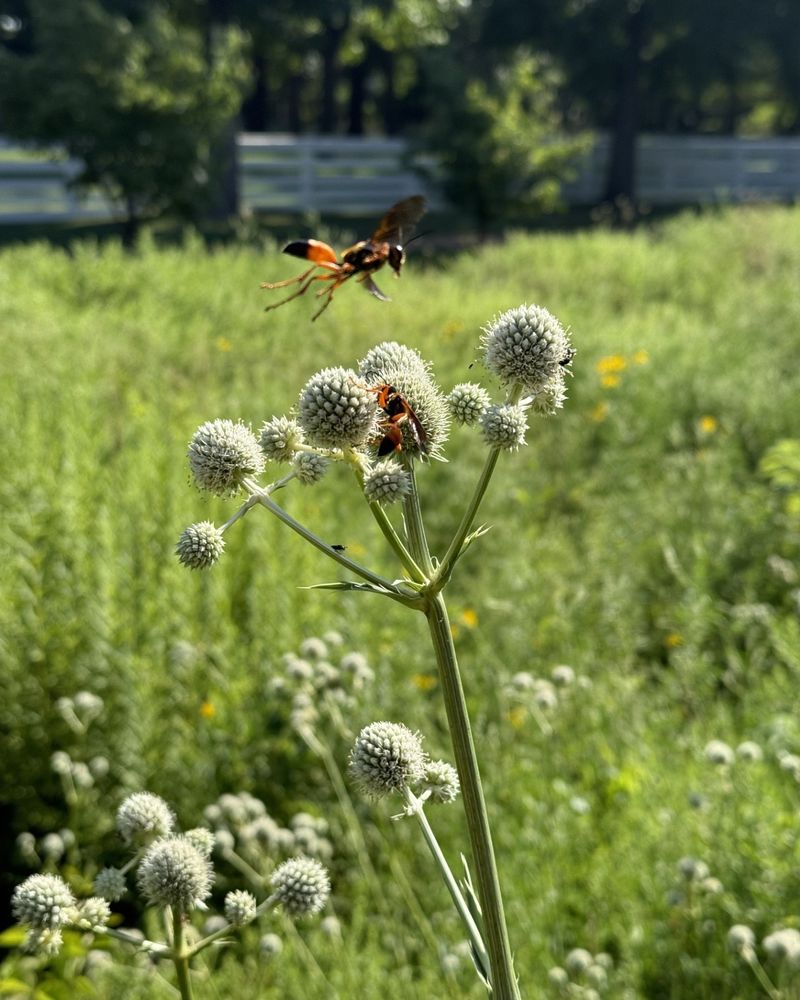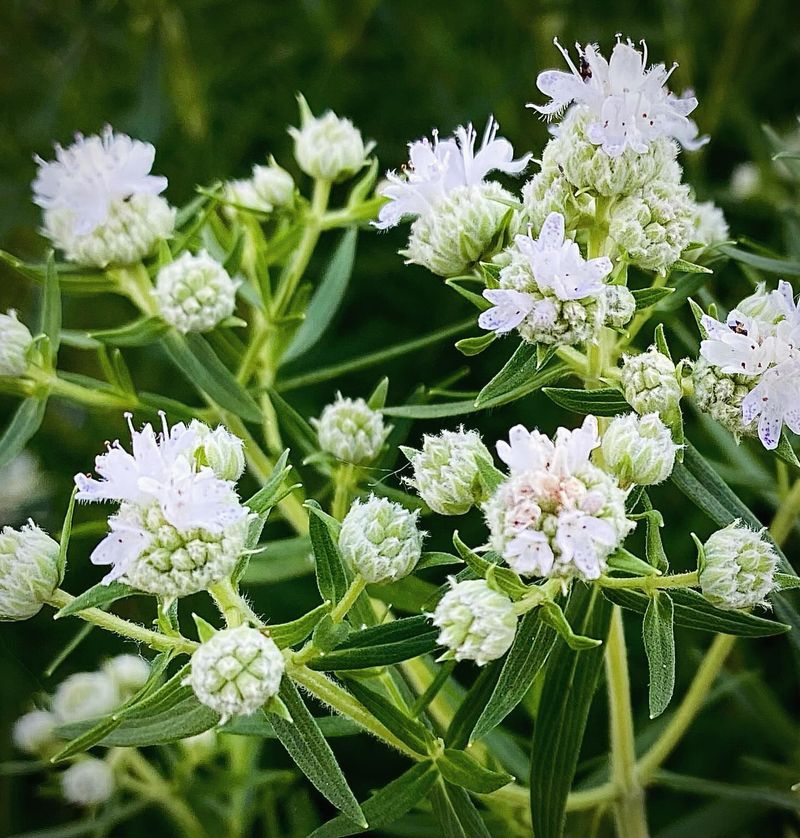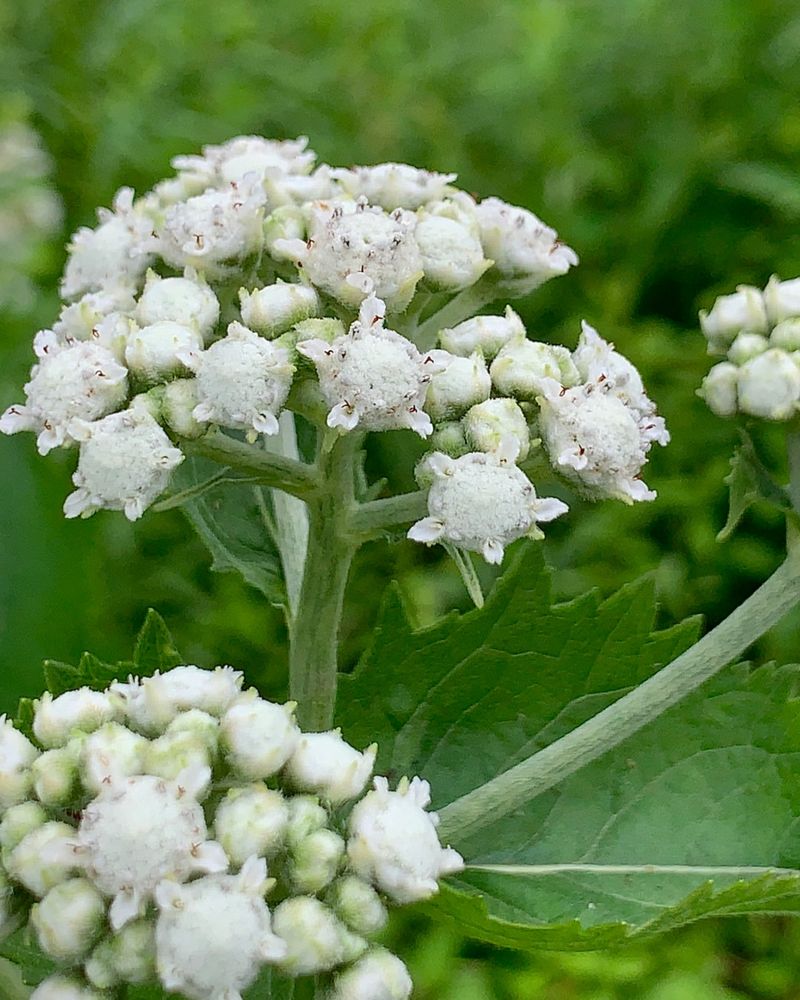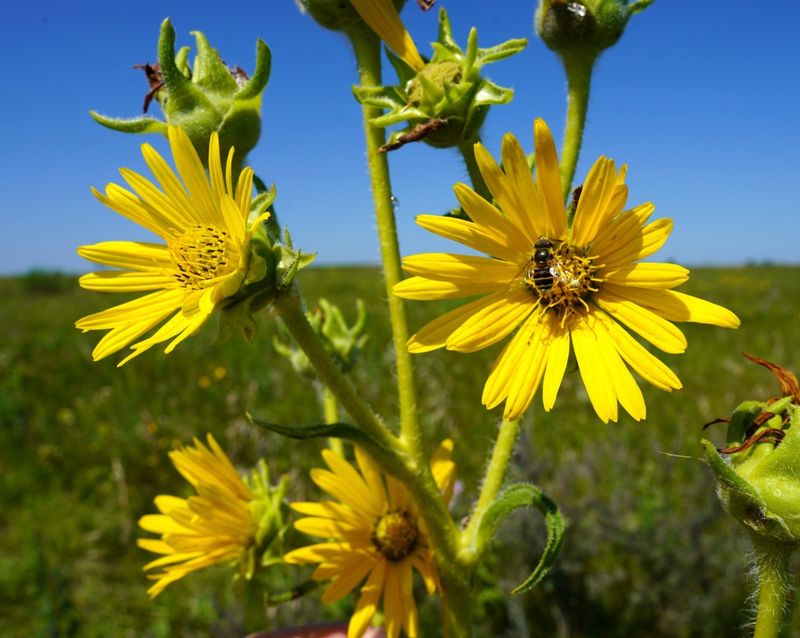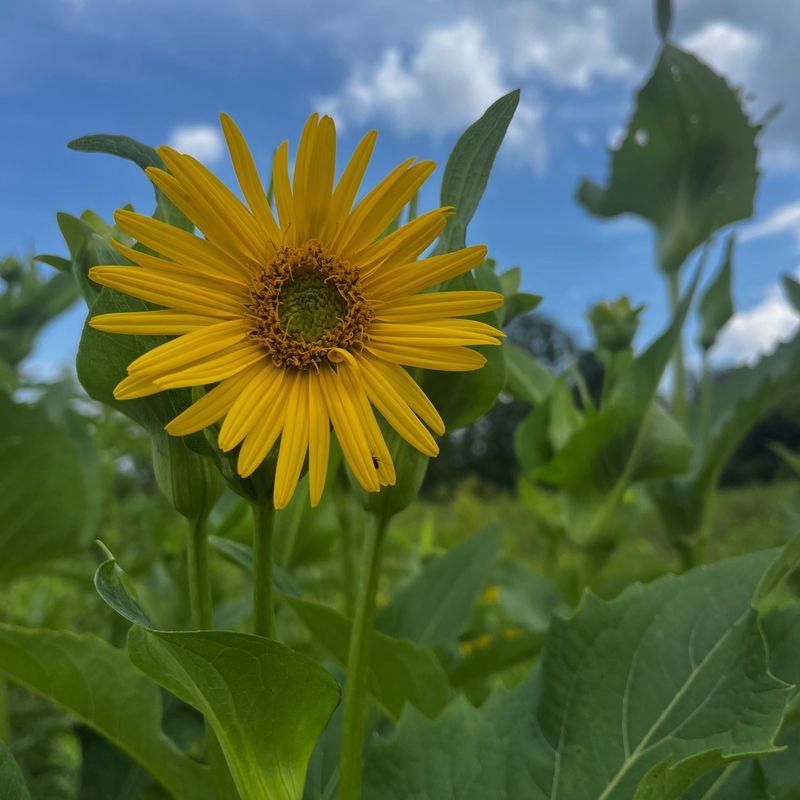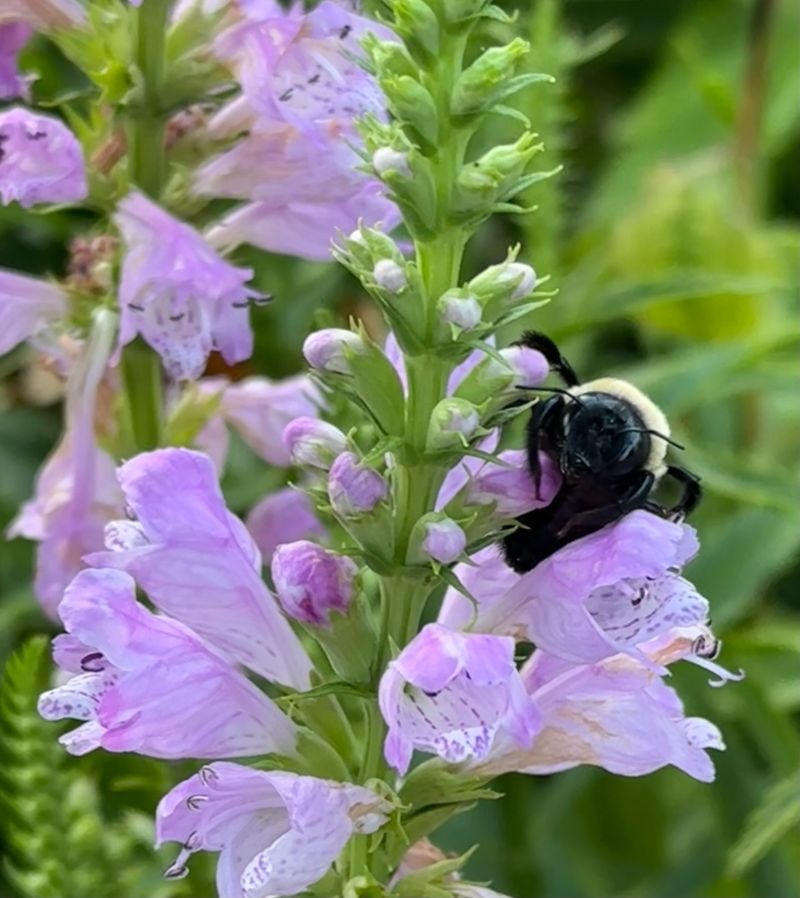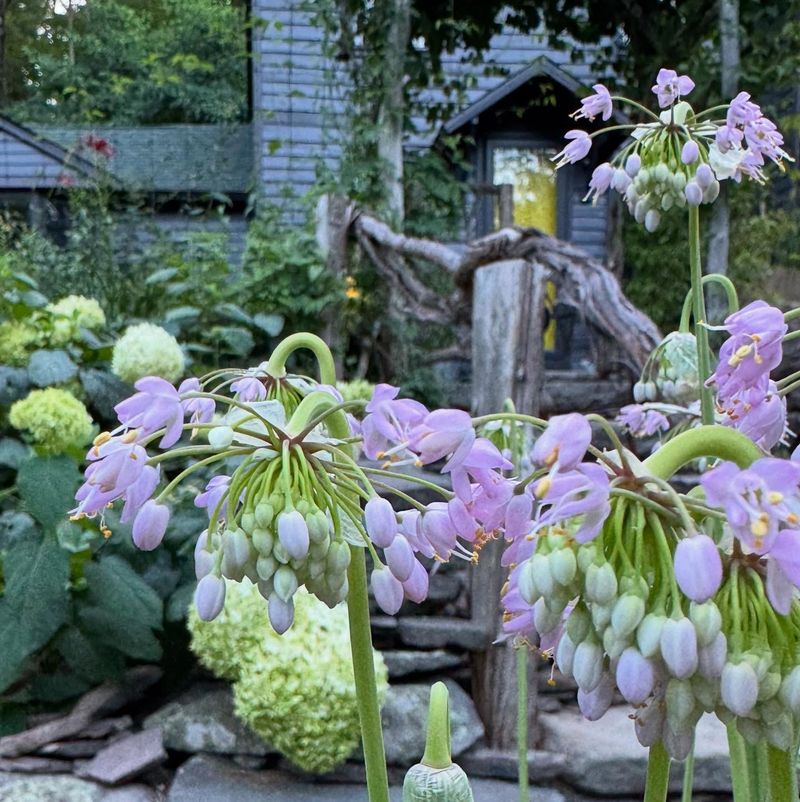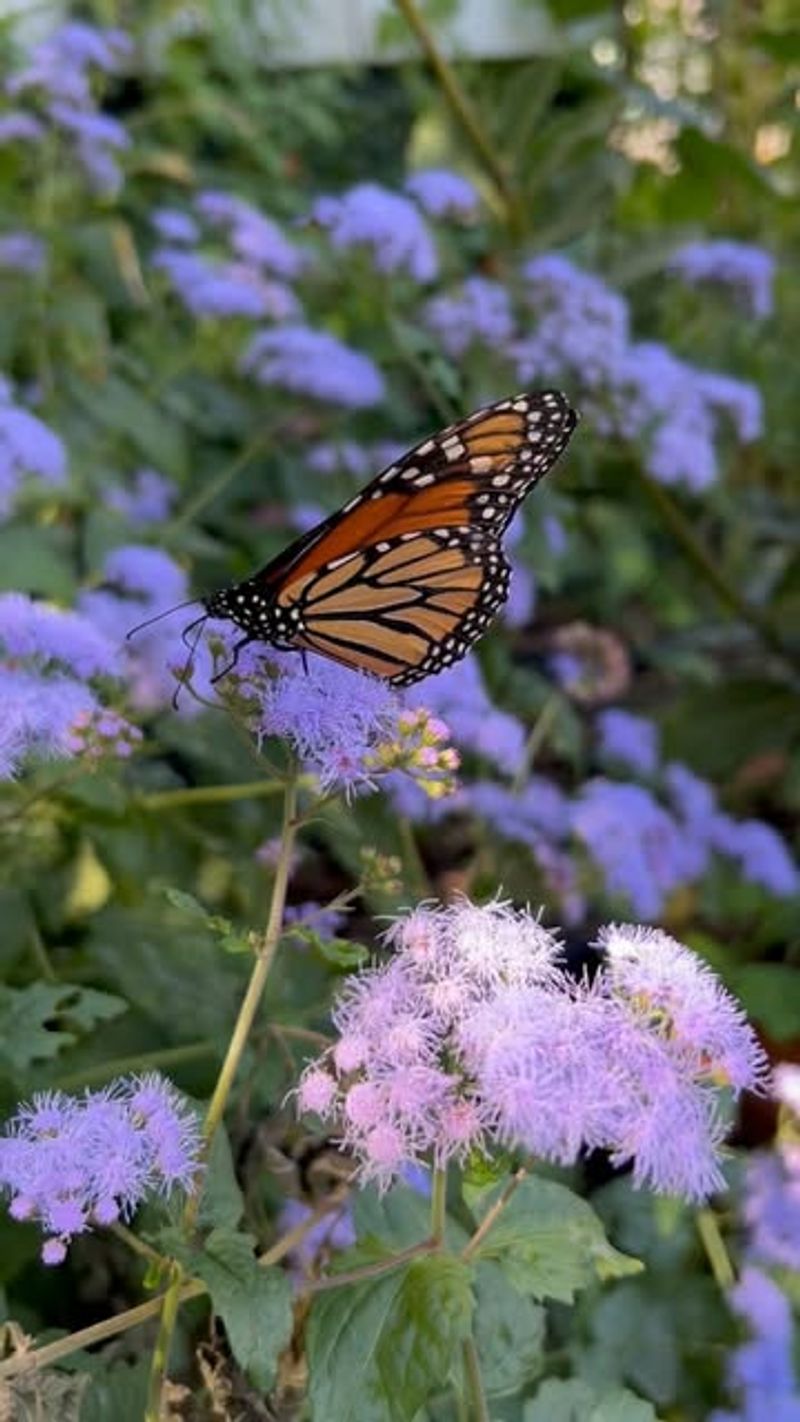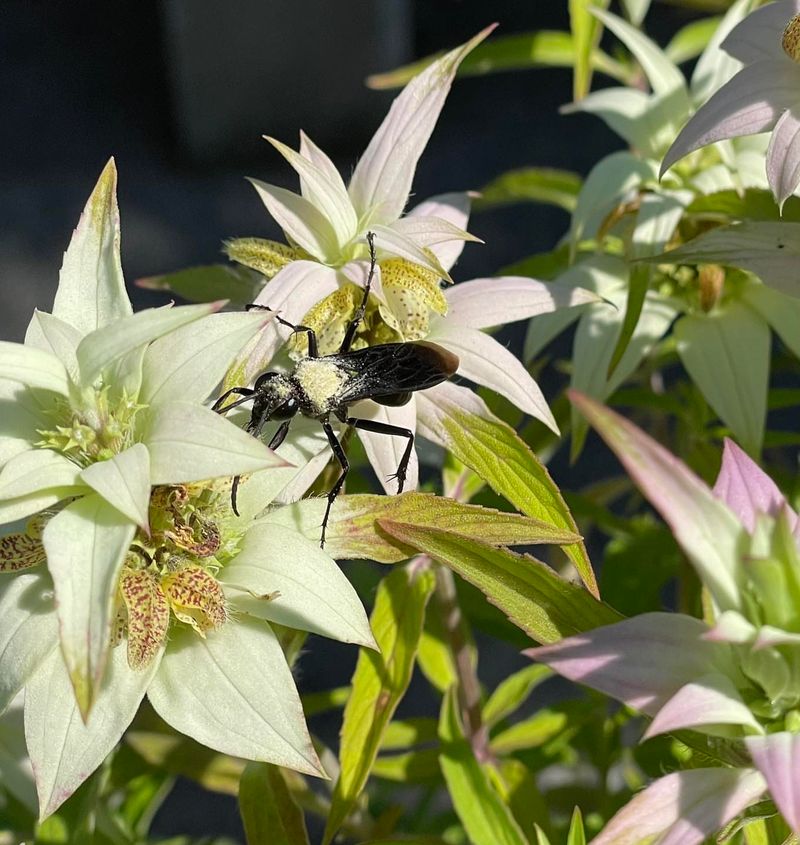August can be a tough month for bees, butterflies, and other pollinators in Illinois. Many spring and early summer flowers have faded, but these native blooms are just hitting their stride.
These resilient plants have evolved to thrive in late summer’s heat and provide crucial nectar and pollen when many other food sources have disappeared.
1. Purple Coneflower (Echinacea purpurea)
Standing tall with distinctive drooping purple petals and spiky orange centers, these beloved prairie flowers are pollinator magnets in Illinois gardens.
Native bees can’t resist their abundant pollen. Beyond their wildlife value, purple coneflowers are drought-resistant once established and make excellent cut flowers. Their seed heads also provide winter food for goldfinches and other small birds.
2. Blazing Star (Liatris spicata)
Sending up dramatic purple spikes that bloom from top to bottom, blazing stars create vertical interest in the August garden. Their unusual blooming pattern (most flowers bloom bottom-up) makes them stand out.
Butterflies particularly adore these flowers, and you’ll often see monarchs stopping for nectar during their migration. The plants grow from corms that multiply over time, creating impressive clumps.
3. Joe-Pye Weed (Eutrochium purpureum)
Reaching impressive heights of 5–7 feet, Joe-Pye weed creates a dramatic backdrop in any pollinator garden. The large, dusky pink flower clusters can span a foot across, creating landing pads for countless butterflies.
Despite its unfortunate name, this native plant isn’t weedy at all. The vanilla-scented flowers attract swallowtails, monarchs, and numerous bee species from July through September in Illinois gardens.
4. Wild Bergamot (Monarda fistulosa)
Lavender pom-pom blooms sit atop aromatic foliage, creating a feast for both bees and hummingbirds throughout summer. The ragged, tubular flowers perfectly match the long tongues of certain bee species.
Also known as bee balm, this mint family member has leaves that make a delicious tea. The plants spread by rhizomes, quickly forming colonies that provide reliable August blooms even during drought conditions.
5. Black-Eyed Susan (Rudbeckia hirta)
Cheerful yellow daisies with distinctive dark centers brighten Illinois gardens from July through frost. These short-lived perennials readily self-seed, ensuring continuous blooms year after year. Bees and small native butterflies flock to black-eyed Susans, while the seed heads later feed songbirds.
Their drought tolerance makes them perfect for hot August weather, continuing to flower when many other plants have given up.
6. Ironweed (Vernonia fasciculata)
Intensely purple flower clusters top this tall prairie native in late summer, creating a royal display that butterflies can’t resist. The deep color stands out dramatically against the golden hues of August grasses.
Despite its tough-sounding name, ironweed produces some of the most delicate and richly colored flowers in the late summer garden. Its deep root system helps it thrive during dry periods common in Illinois Augusts.
7. Goldenrod (Solidago species)
Much maligned but utterly essential, goldenrods support more pollinator species than almost any other late summer flower. Their bright yellow plumes signal the changing seasons while feeding countless beneficial insects.
Contrary to popular belief, goldenrod doesn’t cause hay fever (that’s ragweed’s fault). Illinois boasts several native species, from the tall Solidago altissima to the more compact Solidago speciosa, all providing crucial August-September pollinator food.
8. Cardinal Flower (Lobelia cardinalis)
Brilliant scarlet spikes light up shady stream banks and wetland edges throughout Illinois in August. Hummingbirds are particularly drawn to these intensely red tubular flowers that perfectly match their long bills.
Cardinal flowers need consistent moisture, making them perfect for rain gardens or pond edges. The dramatic color provides a striking contrast to the predominantly yellow and purple palette of other late summer blooms.
9. Great Blue Lobelia (Lobelia siphilitica)
Electric blue spires emerge in moist areas during August, providing rare true-blue color in the late summer garden. Long-tongued bees and the occasional hummingbird visit these unusual tubular flowers.
A cousin to cardinal flower, great blue lobelia prefers similar moist conditions but offers a completely different color palette. The plants self-seed moderately, creating sustainable colonies in Illinois gardens without becoming invasive.
10. Culver’s Root (Veronicastrum virginicum)
Elegant white candelabra-like flower spikes attract tiny native bees and hover flies in abundance. The whorled leaves create architectural interest even before the August blooms appear.
While not as flashy as some prairie flowers, Culver’s root serves as an important pollen source for specialized small pollinators. Its stately presence in the back of borders provides vertical interest at a time when many spring bloomers have faded.
11. Prairie Blazing Star (Liatris pycnostachya)
Taller and more dramatic than its cousin Liatris spicata, prairie blazing star sends up 4-5 foot purple spikes that monarch butterflies find irresistible during their August migration through Illinois.
The densely packed flowers create a dramatic vertical element in the landscape. Their deep tap roots make them extremely drought tolerant once established, perfect for surviving Illinois’ sometimes dry late summers.
12. Rattlesnake Master (Eryngium yuccifolium)
Otherworldly white spherical flower heads top yucca-like foliage, creating one of the most distinctive native plants in Illinois prairies. Specialized wasps and small native bees frequent the unusual blooms.
The plant’s common name comes from an old belief that it could cure rattlesnake bites. While that’s just folklore, its value to small pollinators is very real, providing crucial nectar through August’s heat.
13. Mountain Mint (Pycnanthemum virginianum)
Silvery bracts surround tiny white flowers, creating a frosted appearance that’s surprisingly attractive to an astonishing diversity of beneficial insects. Some pollinator experts rank mountain mint as the single best plant for supporting native bees.
Despite its name, this mint family member isn’t aggressive like culinary mint. The aromatic foliage deters deer and rabbits while providing a pleasant fragrance when brushed against in the August garden.
14. Wild Quinine (Parthenium integrifolium)
Flat-topped clusters of tiny white flowers attract an amazing variety of small native bees, wasps, and flies in Illinois gardens throughout summer. The blooms persist for months, providing reliable pollinator food from June through August.
The plant’s common name comes from its historical use as a quinine substitute during the Civil War. Today, its main value is ecological, supporting specialized pollinators that are often overlooked in garden planning.
15. Compass Plant (Silphium laciniatum)
Towering up to 8 feet tall, compass plants send up stalks dotted with large yellow daisy-like flowers that feed bees and butterflies. The deeply cut leaves align north-south to minimize water loss in the hot prairie sun.
Native Americans used compass plants medicinally, while pioneers used them as living signposts. Their incredibly deep roots (up to 15 feet!) allow them to access water during August droughts, ensuring reliable blooms for pollinators.
16. Cup Plant (Silphium perfoliatum)
Large yellow flowers top these 8-foot giants, while the distinctive leaves form cups that collect rainwater, providing drinking spots for pollinators and birds. Goldfinches particularly love the seeds that follow the August blooms.
Cup plants spread vigorously through rhizomes, quickly forming impressive colonies. While too aggressive for small gardens, they’re perfect for large restoration projects where their size creates habitat structure for birds and insects alike.
17. Obedient Plant (Physostegia virginiana)
Spikes of pink snapdragon-like flowers brighten moist areas in Illinois gardens during August, attracting long-tongued bees and the occasional hummingbird. The common name comes from how the individual flowers stay in place when pushed to the side.
While beautiful, obedient plant can spread aggressively in rich soil. Plant it where it has room to roam or in containers to enjoy its late-season blooms without worry. Deer typically avoid the slightly aromatic foliage.
18. Nodding Onion (Allium cernuum)
Delicate pink flowers hang from curved stems like little bells, creating charming August interest in drier garden areas. Native bees, especially small specialist species, rely on these late-blooming bulbs.
Unlike many spring-blooming bulbs, nodding onions save their display for mid-to-late summer when many other flowers have faded. The entire plant is edible with a mild onion flavor, though they’re more valuable left for pollinators.
19. Blue Mistflower (Conoclinium coelestinum)
Fluffy clusters of true-blue flowers create clouds of color in moist areas of Illinois gardens during late summer. Butterflies, especially skippers and painted ladies, flock to these unusual blooms when many other flowers have faded. Blue mistflower spreads by both seeds and runners, forming dense colonies over time.
While potentially aggressive in perfect conditions, this tendency makes it valuable for difficult spots where reliable August pollinator food is needed.
20. Spotted Beebalm (Monarda punctata)
Whorls of spotted lavender flowers surrounded by showy pink-tinged bracts create one of the most unusual displays in the August garden. Small native bees and wasps particularly favor these complex blooms.
Unlike its more common cousin wild bergamot, spotted beebalm prefers sandy, well-drained soil. The aromatic foliage contains thymol, the same compound found in culinary thyme, giving it a distinctive spicy scent when brushed against.

